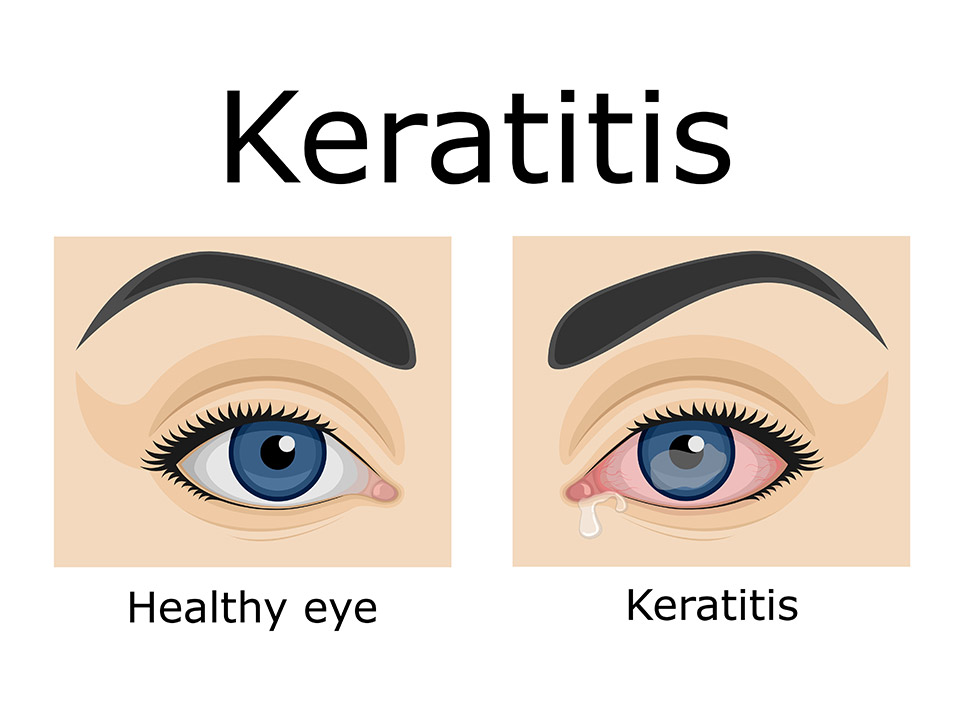Bacterial Keratitis: Causes, Symptoms, And Treatment

Bacterial keratitis is a corneal infection that can lead to severe complications and irreversible visual damage if left untreated. Mild cases of bacterial keratitis can be effectively treated with antibiotics.
Center for Diseases and Control (CDC) estimates that bacterial keratitis is responsible for 1.5–2.0 million new cases of monocular blindness per year. CDC further states that this bacterial infection is the 5th leading cause of blindness and visual impairment globally.
Keratitis is a cornea swelling, i.e., the clear, dome-shaped transparent frontal layer covering the pupil and iris. According to ophthalmologists, this corneal inflammation may be associated with an infection. There is a non-infectious keratitis that can present from a minor injury. But infectious keratitis can arise from bacteria, viruses, fungi, and parasites and cause permanent vision loss if not untreated early enough.
Talk to your doctor if you notice persistent eye redness. A comprehensive eye examination can reveal if it’s due to an infection and how far it has spread. Untreated keratitis is severe and can deprive you of your vision.
Causes of Bacterial Keratitis
Typically, bacterial keratitis affects people who wear contact lenses. The bacterial infection grows on your contact lenses or lens case if you do not clean and store them properly. Also, the condition can come from contaminated eye drops or contact lens solutions. Wearing extended-wear contact lenses makes you more likely to get bacterial keratitis.
Bacterial keratitis may occur due to the following:
Viral Infections
Viral infections due to the herpes simplex virus, the chicken pox virus, or the common cold are among the leading causes of bacterial keratitis. If you have a common cold or suffering from chicken pox, resist the urge to rub your eyes with your hands. The hands are breeding grounds for the viruses that may cause keratitis.
Also, always keep your hands clean to prevent repeated keratitis infections. Repeat infections can severely damage your eyesight over a short time.
Parasitic Infection
Parasitic infection is another significant cause of bacterial keratitis. When your eyes are exposed to microscopic, single-celled organisms or amoeba, you are highly likely to develop keratitis. These tiny organisms mainly occur in freshwater and soil. If you use contact lenses, ensure they are always hygienic.
Also, avoid contact with water while wearing contact lenses.
The microorganisms may live on the surface of a contact lens or contact lens carrying case without you realizing it. They contaminate your cornea when you’re wearing your lenses.
Contaminated Water
If you love diving into the pool or immersing yourself in a hot tub during cold seasons, consider your eyes’ safety. Almost all water bodies and bathtubs contain bacteria, fungi, and parasites that can enter your eyes when swimming, resulting in keratitis.
Fungal Infections
Keratitis due to fungal infections is rare, though it’s equally devastating, left untreated. You can get this infection by scratching your eyes with organic material like a branch or plant matter. Also, adhere to your doctor’s directives if you’re using contact lenses or steroid eye drops. A little mistake while using contact lenses may facilitate bacterial keratitis.
Other risk factors that may cause bacterial keratitis are:
- Wearing contact lenses longer than recommended. It can cause damage to your eye and possibly allow infection to enter
- Wearing your contact lenses while you’re in pools, hot tubs, or outdoor water sources
- An injury to your eyes, including surgery
- A weakened immune system
- Poor contact lenses hygiene
- Dry eyes
Bacterial Keratitis Symptoms
The symptoms may vary due to the different causes of bacterial keratitis. The most common symptoms include:
- Blurred vision. Your cornea helps focus sight. The corneal inflammation makes your vision blurred or cloudy. In severe cases, your eyes may swell and shut.
- A gritty feeling in the eye. You experience a sensation of something, like sand, in the eye. You may also have a burning sensation, tearing, or a yellow-green fluid draining from your eyes.
- Sensitivity to light is called photophobia. Your eyes become uncomfortable when exposed to bright lights or strong sunlight.
- Difficulty keeping the eyelids open
- Watery eye
If you notice any of the above symptoms, immediately see an ophthalmologist to avoid damage to the eye or visual loss. Early diagnosis and treatment are essential in managing bacterial keratitis.
Treatments for Bacterial Keratitis
There are numerous treatment techniques for infectious keratitis, and the treatment method depends on the specific cause of the infection. The primary type of treatment for bacterial keratitis is antibiotic eye drops. Your doctor may prescribe the drop frequency depending on the severity of the eye infection.
In more severe cases, you may need to administer eye drops after every thirty minutes during the day and night. If they don’t reduce the pain, you might need oral antibiotics as a supplement. If you are experiencing blurred vision due to fungi, you will need antifungal eye drops and oral antifungal drops to minimize the pain.
Viral keratitis is the most common type, often leading to blindness if not treated early. You will need antiviral eye drops to kill the virus causing the infection. Also, you can use oral antiviral medications for more effective results.
Keratitis caused by the parasite acanthamoeba can be challenging to treat because some acanthamoeba infections are resistant to medication. If acanthamoeba keratitis blurs your vision, you can use anti-parasitic eye drops. The treatment may take longer, while some severe cases may need a cornea transplant.
Your eye care provider may recommend a corneal transplant only if the infection doesn’t respond to medication or if it causes permanent damage to the cornea. Severe corneal damage can significantly impair your vision and general health.
Takeaway
If you notice bacterial keratitis symptoms, stop wearing contact lenses and see an eye doctor immediately. The best way to prevent infectious keratitis is by keeping your hands and the areas around your eyes clean. But more importantly, be on the lookout for any problem with your eyes.
If you feel there’s anything that compromises your vision, talk to your ophthalmologist early enough. The earlier bacterial keratitis is diagnosed, the easier it’s to treat.




